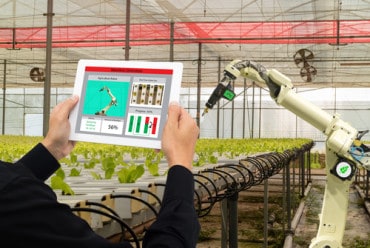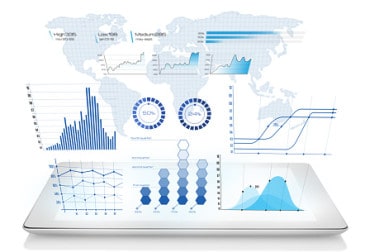
Adding real-time analytics unlocks new use cases for Azure Digital Twins that go beyond modeling infrastructures to enable tracking live, mission-critical systems that have many data sources and are usually performing time-sensitive operations.
Azure Digital Twins let companies create a digital representation of real-world things, places, business processes, and people. Using them, they gain insights that help drive better products, optimize operations and costs, and improve customer experiences. ScaleOut Software recently announced major extensions to the ScaleOut Digital Twin Streaming Service that integrate its Azure-based in-memory computing platform with Microsoft’s Azure Digital Twins cloud service. This integration adds key new capabilities for real-time analytics to Azure Digital Twins and unlocks important new use cases.

RTInsights recently sat down with Dr. William Bain, CEO and founder of ScaleOut Software, to discuss the impact of adding real-time capabilities to Azure Digital Twins, the types of data the twins might use, and use cases for real-time capabilities. Here is a summary of our conversation.
RTInsights: You recently made an announcement about bringing real-time capabilities to Azure Digital Twins. Can you talk about what that means?

Bain: We’re excited to announce our ScaleOut Azure Digital Twins Integration product. It adds what we call a “real-time component” that seamlessly combines the in-memory computing technology in our ScaleOut Digital Twin Streaming Service with the Azure Digital Twins service, which are both running in the Azure cloud.
This product enables Azure Digital Twins to perform real-time analytics on incoming messages for immediate alerting and to enhance situational awareness. With this product, Azure Digital Twins can now simultaneously track and analyze telemetry from thousands or even millions of data sources. The product also adds real-time data aggregation, continuous query, and geospatial visualization capabilities that enhance Azure Digital Twins.
RTInsights: What type of real-time data are we talking about?
Bain: We’re talking about incoming telemetry messages from data sources that have corresponding Azure Digital Twins. For example, Azure Digital Twins might be tracking trucks in a fleet, which are sending messages to a telematics software application. The messages could include engine and cargo parameters, location, speed, lateral acceleration, and other characteristics of the truck at a given time.
Another example would be telemetry from a health-tracking device, such as a Fitbit or another wearable device that sends biometric data to a digital twin, which analyzes that data with knowledge of the user’s specific medical condition to provide highly targeted feedback.
Yet another example would be IoT devices in numerous applications such as a smart cities application, tracking a large infrastructure like an office building, a physical security system that is monitoring entry points, or a power line management system tracking power lines, power poles, and distribution points. Other examples include a water distribution system, irrigation system, or a warehouse with pallets and conveyors.
These systems generate messages from physical data sources, and those messages can be received and analyzed by digital twins, such as Azure Digital Twins.
RTInsights: How does in-memory computing enable real-time analytics in Azure Digital Twins?
Bain: Our in-memory computing technology is the key to the high performance of our ScaleOut Digital Twin Streaming Service. This technology hosts data objects in memory, and it distributes them across a cluster of virtual servers running in the cloud. It uses an integrated, software-based compute engine to run application-defined methods with extremely low latency.
So, in-memory computing overcomes the limitations of using serverless functions, thereby providing low latency method execution with sub-millisecond access to digital twin properties. It also avoids overheads from repeated scheduling and authentication that you would find in serverless functions.
This technology accelerates message handling and analysis, enabling fast real-time analytics. It also simplifies development for application developers by using a single integrated programming model with rich features such as optional rules-based programming and built-in machine learning to analyze incoming message data.
RTInsights: This capability offers synergistic benefits to those already using Azure Digital Twins. What type of things does it let those users do that they couldn’t do before?
Bain: Adding real-time analytics unlocks new use cases for Azure Digital Twins that go beyond modeling infrastructures to enable tracking live, mission-critical systems that have many data sources and are usually performing time-sensitive operations. It lets Azure Digital Twins track and analyze incoming messages with much lower latency, higher scalability, and richer functionality, such as machine learning, than was previously possible. It also gives users of the Azure Digital Twins service better situational awareness by adding real-time data aggregation and visualization of digital twin properties.
RTInsights: What changes do those users have to make to take advantage of your solution?
Bain: We designed the ScaleOut Azure Digital Twins Integration product to build on the Azure Digital Twin architecture with simple, straightforward extensions. We add an Azure Digital Twin component, which is part of the Azure Digital Twin architecture. This component hosts real-time properties, and it seamlessly integrates into an Azure Digital Twin model. We also automatically update the properties of the real-time component from our in-memory computing platform as messages are processed.
We include APIs for accessing and updating Azure Digital Twin properties during message processing so that this capability does not have to be implemented using separate serverless functions and the Azure Event Grid.

Users can take advantage of our real-time analytics by migrating functionality, which otherwise needs to run in multiple serverless functions, into a single message processing method running on our in-memory computing platform. This method can be implemented in C#, Java, using a rules-based language, or just by configuring machine learning with no code required. All Azure Digital Twins features, such as relationships between digital twins, and the Azure Digital Twins tools, such as the Azure Digital Twin Explorer, work identically as before. Azure tools can access real-time properties as a standard component of a model and use those properties as they would any other properties hosted in Azure Digital Twins.
RTInsights: What applications need this capability?
Bain: In general, applications that need real-time analytics use Azure Digital Twins to track dynamic state changes in their physical data sources. These applications typically need to spot emerging issues and react quickly to avoid problems, or in some cases, to capture new opportunities that they otherwise might miss.
Other attributes of these applications typically include many data sources and a high volume of incoming messages. Also, the time constraints may be just too high to manually screen for anomalies by using tools that just view Azure Digital Twin properties. Having the ability to continuously screen incoming data and analyze it, searching for unusual conditions, anomalies, or opportunities, is the real value created by real-time analytics with in-memory computing.
RTInsights: Can you discuss some use cases for this?
Bain: We see a large number of use cases across a wide range of applications that real-time analytics makes accessible to Azure Digital Twins. They include:
Fleet management: We talked a little bit about telematics, tracking a fleet of trucks or rental cars, which can number in the tens of thousands. The goal is to detect issues with engines or cargo to enable preventive maintenance that avoids problems before they become serious or expensive. Companies also want to detect lost, erratic, or timed-out drivers. It can be a problem in the industry when operators drive longer than the time that they’re allotted legally. Dispatchers want to detect hazardous road conditions or weather problems that might affect many vehicles. And they want to optimize overall fleet operations, such as ensuring on-time deliveries and minimizing fuel usage. These are all things that could be accomplished with Azure Digital Twins using real-time analytics.
Health-device tracking: Another category is health-device tracking that involves analyzing biometric data from wearable devices. By combining an individual’s medical history, current medications, recent activity, and other parameters that are held within an Azure Digital Twin instance, this telemetry can be analyzed to spot issues before they become major medical problems for the wearer and provide feedback that helps guide the wearer.
Physical security: Here, an application can use digital twins to track entry points in a large infrastructure, such as an oil refinery, factory, or corporate campus. Azure Digital Twins also can track card key holders as they enter and exit to validate their authorization, detect that they are currently employed, and make sure they are qualified to enter a particular area of the infrastructure for safety reasons.
Also, digital twins can be used to detect patterns of unauthorized access at entry points, usual patterns of entry in the middle of the night, or open doors that normally would be closed. Managers can be immediately alerted when unusual activity is detected.
Cyber security: The notion of tracking security can be extended into cyber security to track activity at network nodes, such as routers in a large corporate network. For example, a digital twin might be used to detect unusual login attempts and login failures or access to servers and databases that should be off-limits to a particular user. Digital twins also might be used to identify and interrupt a potential cyber kill chain as an intruder enters a network and moves among various nodes within the network.
Logistics tracking pallets and conveyors in a warehouse: The genesis of the ScaleOut Azure Digital Twins Integration came from discussions with a potential customer about tracking conveyors in a warehouse using Azure Digital Twins. Users can detect issues with lost or delayed packages or pallets and know exactly where they are by maintaining digital twins for each of these items and dynamically updating their location and condition on a second-by-second basis. Also, the technology can identify issues with conveyor systems to make sure they’re running smoothly and operating correctly.
IoT and smart cities applications: Real-time analytics with digital twins can be used for tracking IoT devices in many applications, such as smart cities applications. For example, a digital twin can be used to minimize energy consumption by monitoring usage, detecting issues such as leaks, identifying thermostats that are at the wrong setting, or any kind of condition that could affect energy usage or safety.
A smart city application might use digital twins to detect unusual sounds at intersections, such as gunfire, and to track their progression by having digital twins monitor street intersections where the sound sensors are located. This would help first responders determine the scope of an attack and address that attack in a timely way with the right resources.
A similar approach might be used to track the progression of forest fires in a power line network. When a fire emerges, authorities can use digital twins to track its progression and direct evacuations and emergency personnel to minimize the impact.
eCommerce: Digital twins can be applied to e-commerce to track customers as they’re shopping for products, identify the products that they’re looking for, and match their needs. For example, a digital twin might analyze the shopping pattern that a shopper is engaged in, such as whether they are searching for a product with specific characteristics. This information can be combined with knowledge of the shopper’s history, brand preferences, and popular trends to optimize recommendations that match that shopper’s needs. That’s an untapped use of digital twins that real-time analytics makes possible.
In general, we see a growing list of application areas where real-time analytics can enhance the ability of digital twins to spot issues, capture opportunities, and optimize operations well beyond what being done today.






























